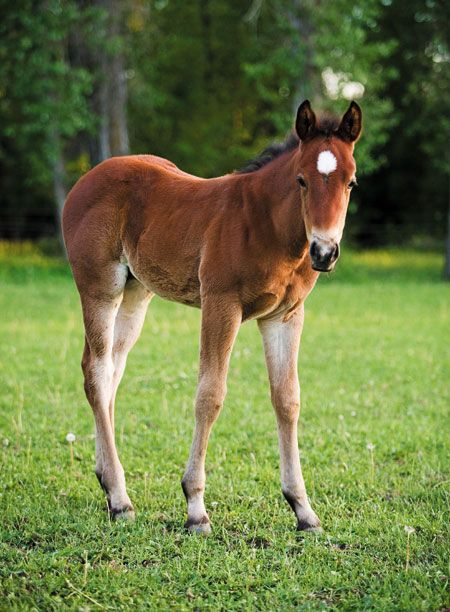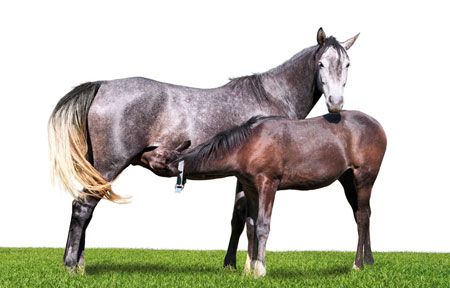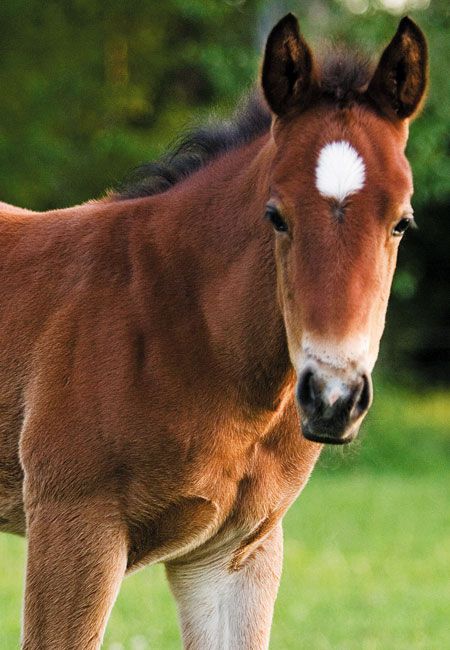SLIDESHOW: Growing concerns for development in foals
Consider these facts about foal development, nutrition.
Next >

Before birth, the bone begins as cartilage. During the last few months of development, three to four months before birth, the cartilage begins ossification. At birth, almost 80 percent of the bone is somewhat mineralized.
Photo by Getty Images

At birth, as noted by Laurie Lawrence, PhD, professor of nutrition, University of Kentucky, a foal has 17 percent of its bone mineral content and 10 percent of its mature body weight. Thoroughbreds, similar to other horses, will reach 84 percent of their mature height and 46 percent of mature weight by six months, 94 percent of height and 65 percent of weight by one year, and almost complete their growth-reaching full height and 90 percent of mature weight-by 22 months. Unlike height and weight, bone mineralization takes more time since horses are at 68.5 percent of total bone mineral content by six months and 76 percent by one year. They don't reach maximal bone mineral content until 6 years of age
Photo by Getty Images/Vetta.

From birth to 1.5 years, during the period of early development, all of the foal's body systems are functioning, but the musculoskeletal system is changing markedly, as bones are elongating, putting on mass and solidifying and muscles are gaining in bulk and strength.
Throughout the body, proper skeletal development is critical to the horse's long-term health and ability to move soundly. Without proper formation, the young foal may develop skeletal deformities and other conditions that may lead to bone and joint degradation and developmental bone disease later in life.
Photo by Getty Images

As foals grow, the bones (especially the long ones) are laying down protein and minerals. The organic material of the bony tissue is a collagen matrix of highly cross-linked protein, which makes up about 80 to 90 percent of the bone mass. The remaining 10 to 15 percent of the organic material is noncollagenous proteins.
Foal growth primarily includes proper muscle and bone growth. As a major portion of foal growth, bone turnover is a process of continual maintenance and repair and homeostasis. The cells associated with bone resorption are osteoclasts, while bone formation is the function of the osteoblasts.
Photo by Getty Images

Skeletal muscle makes up about 50 percent of the body's mass. As the fetus' muscle develops during the latter stages of pregnancy, glycogen (the muscle store of energy) increases to provide the muscle with a high store of energy at the time of birth and provides energy so the foal can run within hours of parturition.
Photo by Getty Images

Growth rate matters. Growing too slowly may not result in a preferable size at a particular age or may keep a horse from reaching its optimal stature. Growing too fast is a concern for creating skeletal problems that may affect a foal's eventual athletic performance and health. Do not allow a growing horse to put on excess weight or grow too quickly because it might affect skeletal fitness at a later age. Growth potential is not based solely on genetics but may be modified by other factors, including management practices (see “Risk factors for equine osteocondrosis” in the August 2012 issue of DVM newsmagazine).
Photo courtesy of Mary Rose Paradis, DVM, MS, DACVIM, Tufts University Cummings School of Veterinary Medicine

Once foals begin eating solid food, a typical foal grain ration contains about 1.4 mcal digestible energy per pound. A foal should probably eat about three pounds of grain per day to support the desired growth rate. Foals should have restricted, not unlimited, access to supplemental creep feed. The foal should be properly fed a specific amount, which can be adjusted as the body condition of the foal is continually monitored.
Regardless of food intake, sufficient paddock exercise for a foal is a necessity to ensure healthy skeletal integrity.
Photo by Getty Images